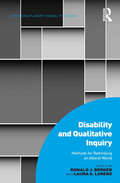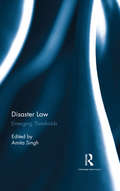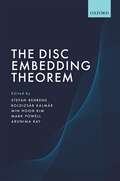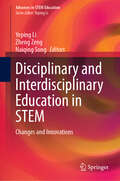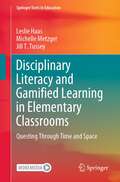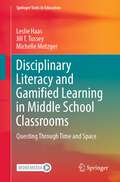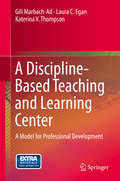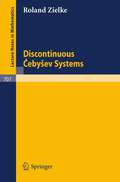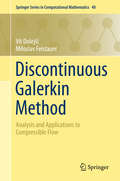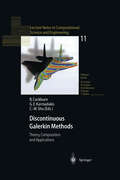- Table View
- List View
Dirichlet Series and Automorphic Forms: Lezioni Fermiane (Lecture Notes in Mathematics #189)
by A. WeilDisability and Qualitative Inquiry: Methods for Rethinking an Ableist World (Interdisciplinary Disability Studies)
by Ronald J. Berger Laura S. LorenzThis groundbreaking text makes an intervention on behalf of disability studies into the broad field of qualitative inquiry. Ronald Berger and Laura Lorenz introduce readers to a range of issues involved in doing qualitative research on disabilities by bringing together a collection of scholarly work that supplements their own contributions and covers a variety of qualitative methods: participant observation, interviewing and interview coding, focus groups, autoethnography, life history, narrative analysis, content analysis, and participatory visual methods. The chapters are framed in terms of the relevant methodological issues involved in the research, bringing in substantive findings to illustrate the fruits of the methods. In doing so, the book covers a range of physical, sensory, and cognitive impairments. This work resonates with themes in disability studies such as emancipatory research, which views research as a collaborative effort with research subjects whose lives are enhanced by the process and results of the work. It is a methodological approach that requires researchers to be on guard against exploiting informants for the purpose of professional aggrandizement and to engage in a process of ongoing self-reflection to clear themselves of personal and professional biases that may interfere with their ability to hear and empathize with others.
Disability and Qualitative Inquiry: Methods for Rethinking an Ableist World (Interdisciplinary Disability Studies)
by Ronald J. Berger Laura S. LorenzThis groundbreaking text makes an intervention on behalf of disability studies into the broad field of qualitative inquiry. Ronald Berger and Laura Lorenz introduce readers to a range of issues involved in doing qualitative research on disabilities by bringing together a collection of scholarly work that supplements their own contributions and covers a variety of qualitative methods: participant observation, interviewing and interview coding, focus groups, autoethnography, life history, narrative analysis, content analysis, and participatory visual methods. The chapters are framed in terms of the relevant methodological issues involved in the research, bringing in substantive findings to illustrate the fruits of the methods. In doing so, the book covers a range of physical, sensory, and cognitive impairments. This work resonates with themes in disability studies such as emancipatory research, which views research as a collaborative effort with research subjects whose lives are enhanced by the process and results of the work. It is a methodological approach that requires researchers to be on guard against exploiting informants for the purpose of professional aggrandizement and to engage in a process of ongoing self-reflection to clear themselves of personal and professional biases that may interfere with their ability to hear and empathize with others.
Disaster Law: Emerging Thresholds
by Amita SinghThis book looks at how legal frameworks can and do reduce risks arising out of disasters. The volume: analyses existing disaster laws and the challenges on the ground; brings together case studies from some of the most vulnerable regions; and proposes solutions to avert existing and possible future crises. The book offers appropriate legal frameworks for disaster management which could not only offer sustainable institutional reforms towards community resilience and preparedness but also reduce risk within the frameworks of justice, equity and accountability. It examines the intricacies of governance within which governments function and discusses how recent trends in infrastructure development and engineering technology could be balanced within the legal principles of ethics, transparency and integrity. The chapters in the volume suggest that legal frameworks ought to resonate with new challenges of resource management and climate change. Further, these frameworks could help secure citizens’ trust, institutional accountability and effective implementation through an unceasing partnership which keeps the community better prepared and more resilient. This volume will be indispensable to scholars and researchers of disaster management, law, public policy, environment and development studies as well as policymakers and those in administrative, governmental, judicial and development sectors.
Disaster Law: Emerging Thresholds
by Amita SinghThis book looks at how legal frameworks can and do reduce risks arising out of disasters. The volume: analyses existing disaster laws and the challenges on the ground; brings together case studies from some of the most vulnerable regions; and proposes solutions to avert existing and possible future crises. The book offers appropriate legal frameworks for disaster management which could not only offer sustainable institutional reforms towards community resilience and preparedness but also reduce risk within the frameworks of justice, equity and accountability. It examines the intricacies of governance within which governments function and discusses how recent trends in infrastructure development and engineering technology could be balanced within the legal principles of ethics, transparency and integrity. The chapters in the volume suggest that legal frameworks ought to resonate with new challenges of resource management and climate change. Further, these frameworks could help secure citizens’ trust, institutional accountability and effective implementation through an unceasing partnership which keeps the community better prepared and more resilient. This volume will be indispensable to scholars and researchers of disaster management, law, public policy, environment and development studies as well as policymakers and those in administrative, governmental, judicial and development sectors.
The Disc Embedding Theorem
Based on Fields medal winning work of Michael Freedman, this book explores the disc embedding theorem for 4-dimensional manifolds. This theorem underpins virtually all our understanding of topological 4-manifolds. Most famously, this includes the 4-dimensional Poincaré conjecture in the topological category. The Disc Embedding Theorem contains the first thorough and approachable exposition of Freedman's proof of the disc embedding theorem, with many new details. A self-contained account of decomposition space theory, a beautiful but outmoded branch of topology that produces non-differentiable homeomorphisms between manifolds, is provided, as well as a stand-alone interlude that explains the disc embedding theorem's key role in all known homeomorphism classifications of 4-manifolds via surgery theory and the s-cobordism theorem. Additionally, the ramifications of the disc embedding theorem within the study of topological 4-manifolds, for example Frank Quinn's development of fundamental tools like transversality are broadly described. The book is written for mathematicians, within the subfield of topology, specifically interested in the study of 4-dimensional spaces, and includes numerous professionally rendered figures.
Disc Winds Matter: Modelling Accretion and Outflows on All Scales (Springer Theses)
by James MatthewsThis thesis describes the application of a Monte Carlo radiative transfer code to accretion disc winds in two types of systems spanning 9 orders of magnitude in mass and size. In both cases, the results provide important new insights. On small scales, the presence of disc winds in accreting white dwarf binary systems has long been inferred from the presence of ultraviolet absorption lines. Here, the thesis shows that the same winds can also produce optical emission lines and a recombination continuum. On large scales, the thesis constructs a simple model of disc winds in quasars that is capable of explaining both the observed absorption and emission signatures – a crucial advance that supports a disc-wind based unification scenario for quasars. Lastly, the thesis also includes a theoretical investigation into the equivalent width distribution of the emission lines in quasars, which reveals a major challenge to all unification scenarios.
Disciplinary and Interdisciplinary Education in STEM: Changes and Innovations (Advances in STEM Education)
by Yeping Li Zheng Zeng Naiqing SongThis book provides an international platform for educators from different STEM disciplines to present, discuss, connect, and develop collaborations in two inter-related ways: (1) sharing and discussing changes and innovations in individual discipline-based education in STEM/STEAM, and (2) sharing and discussing the development of interdisciplinary STEM/STEAM education. Possible relationships and connections between individual disciplines (like mathematics or physics) and STEM education remain under explored and the integration of traditionally individual discipline-based education in STEM education is far from balanced. Efforts to pursue possible connections among traditionally separated individual disciplines in STEM are not only necessary for the importance of deepening and expanding interdisciplinary research and education in STEM, but also for the ever-increasing need of reflecting on and changing how traditional school subjects (like mathematics or physics) can and should be viewed, taught, and learned. Scholars from eight countries/regions provide diverse perspectives and approaches on changes and innovations in STEM disciplinary and interdisciplinary education. Disciplinary and Interdisciplinary Education in STEM will be a great resource to students and researchers in STEM education as well as STEM curriculum developers and teacher educators internationally.
Disciplinary Literacy and Gamified Learning in Elementary Classrooms: Questing Through Time and Space (Springer Texts in Education)
by Leslie Haas Michelle Metzger Jill T. TusseyThis textbook provides real world examples of how disciplinary literacy can incorporate gamified learning opportunities in elementary classrooms (grades K-5 or ages 5-11). It also presents concrete examples of how to seamlessly integrate literacy within other subjects in engaging and unique ways. Furthermore, this text offers practical information related to pedagogy, content, and differentiation for each lesson. Preservice teachers, practicing teachers, instructional coaches, and administrators can benefit from this user-friendly text and its companion digital components, allowing for replication of lessons based on national standards, backed by best-practices, and supported by differentiated pedagogy.This unique volume begins with engineering marvels that span across centuries and locations. The eight chapters focus on the following marvels in chronological order: Great Pyramid of Giza, Stonehenge, Leaning Tower of Pisa, Great Wall of China, Machu Picchu, Panama Canal, Golden Gate Bridge, and International Space Station. By focusing on these specific examples of human ingenuity, opportunities are created to delve into the historical and social aspects of each chapter’s focus. There are also occasions to explore the artistic merit and the art created about and around each focus. Additional teaching opportunities lie in understanding the science, engineering, technology, and math embedded in all featured marvels.Each chapter features an adventure roadmap in the form of a narrative quest set against the chapter’s marvel that guides teachers and student players through embedded activities. Activities are designed for lower elementary school (grades K-2 or ages 5-8) and upper elementary school (grades 3-5 or ages 8-11). Instructional support for both novice and career teachers is provided through differentiation strategies, resource materials, and teaching tips.
Disciplinary Literacy and Gamified Learning in Middle School Classrooms: Questing Through Time and Space (Springer Texts in Education)
by Leslie Haas Jill T. Tussey Michelle MetzgerThis textbook prepares teachers to incorporate gamified learning experiences into middle school classrooms. Its focus provides concrete examples of how to seamlessly integrate literacy across disciplines in a fun, engaging, and unique way for all learners. Furthermore, this book offers practical information related to pedagogy, content, and differentiation for each lesson. Preservice teachers, practicing teachers, instructional coaches, and administrators can benefit from this user-friendly text and its companion digital components, allowing for replication of lessons based on national standards, backed by best-practices, and supported by differentiated pedagogy.This unique book begins with engineering marvels that span across centuries and locations. The ten chapters, in chronological order, are titled: Acropolis, Petra, Colosseum, Chichen Itza, Moai, Red Square, Taj Mahal, Neuschwanstein, Eiffel Tower, and Sydney Opera House. By focusing on specific examples of human ingenuity, opportunities are created to delve into the historical and social aspects of each chapter’s focus. There are also chances to explore the artistic merit and the art created about and around each marvel. Additional teaching moments lie in understanding the science, engineering, technology, and math embedded in all featured marvels. Each chapter offers material lists, resource materials, and visual/graphic images to support understanding. Teaching tips and differentiation strategies are also provided to support novice and career teachers alike.
A Discipline-Based Teaching and Learning Center: A Model for Professional Development
by Gili Marbach-Ad Laura C. Egan Katerina V. ThompsonThis book describes the design and implementation of a discipline-specific model of professional development: the disciplinary Teaching and Learning Center (TLC). TLC was born from a strong commitment to improving undergraduate science education through supporting the front-line educators who play an essential role in this mission. The TLC’s comprehensive approach encompasses consultation, seminars and workshops, acculturation activities for new faculty members, and teaching preparatory courses as well as a certificate program for graduate students. At the University of Maryland, TLC serves biology and chemistry faculty members, postdoctoral associates, and graduate students. The Center is deeply integrated into the departmental culture, and its emphasis on pedagogical content knowledge makes its activities highly relevant to the community that it serves. The book reflects ten years of intensive work on the design and implementation of the model. Beginning with a needs assessment and continuing with ongoing evaluation, the book presents a wealth of information about how to design and implement effective professional development. In addition, it discusses the theory underlying each of the program components and provides an implementation guide for adopting or adapting the TLC model and its constituent activities at other institutions. In this book, the authors describe how they created the highly successful discipline-based Teaching and Learning Center at the University of Maryland. This is a must read for anyone interested in improving higher education.Charles Henderson, Co-Director, Center for Research on Instructional Change in Postsecondary Education, Western Michigan University This book will provide a much-needed resource for helping campus leaders and faculty development professionals create robust programs that meet the needs of science faculty. Susan Elrod, Dean, College of Science and Mathematics, Fresno StateThe authors provide a road map and guidance for higher education professional development in the natural science for educators at all levels. While the examples are from the sciences, the approaches are readily adaptable to all disciplines.Spencer A. Benson, Director of the Centre for Teaching and Learning Enhancement, University of Macau
Disciplining the Transnational Mobility of People (International Political Economy Series)
by Martin Geiger Antoine PéCOUDThis volume scrutinizes new developments in contemporary mobility and migration politics and shows that they are based on a mix of traditional coercive interventions and less repressive and indirect practices.
Discontinuity and Complexity in Nonlinear Physical Systems (Nonlinear Systems and Complexity #6)
by J. A. Tenreiro Machado Dumitru Baleanu Albert C J LuoDiscontinuity in Nonlinear Physical Systems explores recent developments in experimental research in this broad field, organized in four distinct sections. Part I introduces the reader to the fractional dynamics and Lie group analysis for nonlinear partial differential equations. Part II covers chaos and complexity in nonlinear Hamiltonian systems, important to understand the resonance interactions in nonlinear dynamical systems, such as Tsunami waves and wildfire propagations; as well as Lev flights in chaotic trajectories, dynamical system synchronization and DNA information complexity analysis. Part III examines chaos and periodic motions in discontinuous dynamical systems, extensively present in a range of systems, including piecewise linear systems, vibro-impact systems and drilling systems in engineering. And in Part IV, engineering and financial nonlinearity are discussed. The mechanism of shock wave with saddle-node bifurcation and rotating disk stability will be presented, and the financial nonlinear models will be discussed.
Discontinuous Automatic Control (PDF)
by Irmgard Flugge-LotzDiscontinuously working elements (on-off controls) are widely used in automatic control systems. From an engineering point of view they are attractive because they are nearly always Simpler, more rugged, and cheaper to build than continuous controls. But prediction of their effects in the controlled system is sometimes so complicated that engineers have avoided discontinuous control where it would have been preferable to continuous control.Originally published in 1953.The Princeton Legacy Library uses the latest print-on-demand technology to again make available previously out-of-print books from the distinguished backlist of Princeton University Press. These editions preserve the original texts of these important books while presenting them in durable paperback and hardcover editions. The goal of the Princeton Legacy Library is to vastly increase access to the rich scholarly heritage found in the thousands of books published by Princeton University Press since its founding in 1905.
Discontinuous Dynamical Systems on Time-varying Domains (Nonlinear Physical Science)
by Albert C. Luo"Discontinuous Dynamical Systems on Time-varying Domains" is the first monograph focusing on this topic. While in the classic theory of dynamical systems the focus is on dynamical systems on time-invariant domains, this book presents discontinuous dynamical systems on time-varying domains where the corresponding switchability of a flow to the time-varying boundary in discontinuous dynamical systems is discussed. From such a theory, principles of dynamical system interactions without any physical connections are presented. Several discontinuous systems on time-varying domains are analyzed in detail to show how to apply the theory to practical problems. The book can serve as a reference book for researchers, advanced undergraduate and graduate students in mathematics, physics and mechanics. Dr. Albert C. J. Luo is a professor at Southern Illinois University Edwardsville, USA. His research is involved in the nonlinear theory of dynamical systems. His main contributions are in the following aspects: a stochastic and resonant layer theory in nonlinear Hamiltonian systems, singularity on discontinuous dynamical systems, and approximate nonlinear theories for a deformable-body.
Discontinuous Dynamics and System Synchronization (Nonlinear Systems and Complexity #39)
by Fuhong MinThis book provides a systematic introduction to the dynamical behaviors of discontinuous dynamical systems and system synchronization. The first part of the book presents the theory of flow switching in discontinuous dynamical systems as well as the switching dynamics in such discontinuous systems. The second part presents a theory for interaction discontinuities between distinct dynamical systems, from which partial and complete chaotic synchronizations in such systems are studied analytically and experimentally.
Discontinuous Finite Elements in Fluid Dynamics and Heat Transfer (Computational Fluid and Solid Mechanics)
by Ben Q. LiOver the past several years, significant advances have been made in developing the discontinuous Galerkin finite element method for applications in fluid flow and heat transfer. Certain unique features of the method have made it attractive as an alternative for other popular methods such as finite volume and finite elements in thermal fluids engineering analyses. This book is written as an introductory textbook on the discontinuous finite element method for senior undergraduate and graduate students in the area of thermal science and fluid dynamics. It also can be used as a reference book for researchers and engineers who intend to use the method for research in computational fluid dynamics and heat transfer. A good portion of this book has been used in a course for computational fluid dynamics and heat transfer for senior undergraduate and first year graduate students. It also has been used by some graduate students for self-study of the basics of discontinuous finite elements. This monograph assumes that readers have a basic understanding of thermodynamics, fluid mechanics and heat transfer and some background in numerical analysis. Knowledge of continuous finite elements is not necessary but will be helpful. The book covers the application of the method for the simulation of both macroscopic and micro/nanoscale fluid flow and heat transfer phenomena.
Discontinuous Galerkin Method: Analysis and Applications to Compressible Flow (Springer Series in Computational Mathematics #48)
by Vít Dolejší Miloslav FeistauerThe subject of the book is the mathematical theory of the discontinuous Galerkin method (DGM), which is a relatively new technique for the numerical solution of partial differential equations. The book is concerned with the DGM developed for elliptic and parabolic equations and its applications to the numerical simulation of compressible flow. It deals with the theoretical as well as practical aspects of the DGM and treats the basic concepts and ideas of the DGM, as well as the latest significant findings and achievements in this area. The main benefit for readers and the book’s uniqueness lie in the fact that it is sufficiently detailed, extensive and mathematically precise, while at the same time providing a comprehensible guide through a wide spectrum of discontinuous Galerkin techniques and a survey of the latest efficient, accurate and robust discontinuous Galerkin schemes for the solution of compressible flow.
Discontinuous Galerkin Methods: Theory, Computation and Applications (Lecture Notes in Computational Science and Engineering #11)
by Bernardo Cockburn George E. Karniadakis Chi-Wang ShuA class of finite element methods, the Discontinuous Galerkin Methods (DGM), has been under rapid development recently and has found its use very quickly in such diverse applications as aeroacoustics, semi-conductor device simula tion, turbomachinery, turbulent flows, materials processing, MHD and plasma simulations, and image processing. While there has been a lot of interest from mathematicians, physicists and engineers in DGM, only scattered information is available and there has been no prior effort in organizing and publishing the existing volume of knowledge on this subject. In May 24-26, 1999 we organized in Newport (Rhode Island, USA), the first international symposium on DGM with equal emphasis on the theory, numerical implementation, and applications. Eighteen invited speakers, lead ers in the field, and thirty-two contributors presented various aspects and addressed open issues on DGM. In this volume we include forty-nine papers presented in the Symposium as well as a survey paper written by the organiz ers. All papers were peer-reviewed. A summary of these papers is included in the survey paper, which also provides a historical perspective of the evolution of DGM and its relation to other numerical methods. We hope this volume will become a major reference in this topic. It is intended for students and researchers who work in theory and application of numerical solution of convection dominated partial differential equations. The papers were written with the assumption that the reader has some knowledge of classical finite elements and finite volume methods.
Discontinuous Galerkin Methods for Viscous Incompressible Flow (Advances in Numerical Mathematics)
by Guido Kanschatthe so called standard superconvergent div 6 PREFACE Contents 1 Basics 15 1.1 Meshes and shape functions ... ... .... ... .... .... ... ... 15 1.2 Spaces and approximation .... ... .... ... .... .... ... ... 19 2 Linear Diffusion I 33 3 Linear Diffusion II 67 4 Stokes Equations 89 8 CONTENTS 5 Flow Problems 105 5.1 Advection-Diffusion-ReactionEquation .. .... .... ... .... ... . 107 5.2 Oseen Equations .... ... .... ... .... .... ... .... ... . 110 5.3 Navier-Stokes Equations ... .... ... .... .... ... .... ... . 112 6 Linear Solvers 131 6.1 Krylov space methods . . . . . .... ... .... .... ... .... ... . 132 6.2 Interior Penalty . .... ... .... ... .... .... ... .... ... . 134 6.3 Local multigrid . .... ... .... ... .... .... ... .... ... . 145 6.4 LDG .... ... .... ... .... ... .... .... ... .... ... . 151 6.5 Advection Diffusion .. ... .... ... .... .... ... .... ... . 158 6.6 Stokes ... ... .... ... .... ... .... .... ... .... ... . 160 6.7 Oseen equations . .... ... .... ... ........ ... .... ... . 162 A Example problems 167 A.1 Meshes and domains .. ... .... ... .... .... ... .... ... . 167 A.2 Poisson equation .... ... .... ... .... .... ... .... ... . 170 A.3 Advection-diffusion-reaction . .... ... .... .... ... .... ... . 171 A.4 Stokes and Oseen equations .. .... ... .... .... ... .... ... . 172 List of Figures 1.1 The set and (if ). . ... .... ... .... .... ... ... 17 1.2 The cel (dark grey) and the neighbor set (grey). Note that a common corner does not result in neighborhood. . . . . .... ... .... .... ... ... 19 2.1 Smallest eigenvalue of on a mesh of squares . .... .... ... ... 38 2.2 Eigenfunction to the smallest eigenvalue of for (left) and (right) on a mesh of squares . . . . . .... ... .... .... ... ... 39 2.3 Accuracy of the interior penalty method depending on the parameter . . ... 44 2.4 Pointwise errors on irregular meshes . . .... ... .... .... ... ... 55 2.5 Adapted mesh (level ) for the point value computation .... ... ... 60 2.6 -error over number of degrees of freedom for CG- , DG- and - elements (left) and (bi-)quadratic elements (right) .. .... .... ... ... 62
Discontinuous Groups and Riemann Surfaces (AM-79), Volume 79: Proceedings of the 1973 Conference at the University of Maryland. (AM-79) (PDF)
by Leon GreenbergStudy 79 contains a collection of papers presented at the Conference on Discontinuous Groups and Ricmann Surfaces at the University of Maryland, May 21-25, 1973. The papers, by leading authorities, deal mainly with Fuchsian and Kleinian groups, Teichmüller spaces, Jacobian varieties, and quasiconformal mappings. These topics are intertwined, representing a common meeting of algebra, geometry, and analysis.
Discounting, LIBOR, CVA and Funding: Interest Rate and Credit Pricing (Applied Quantitative Finance)
by C. Kenyon R. StammProviding the most up-to-date tools and techniques for pricing interest rate and credit products for the new financial world, this book discusses pricing and hedging, funding and regulation, and interpretation, as an essential resource for quantitatively minded practitioners and researchers in finance.


